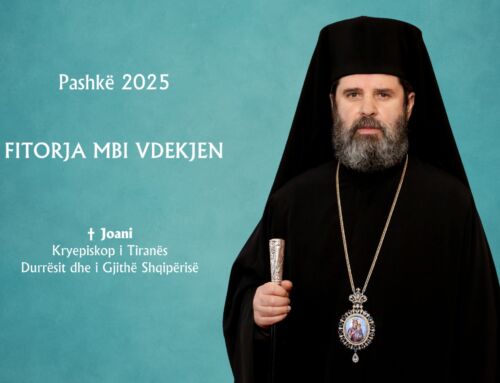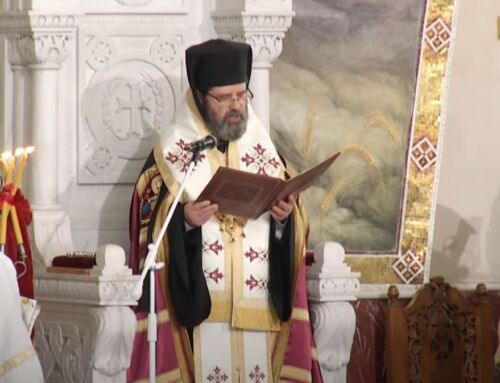The Resurrectional Octoechos Book was recently released and is sold in the book shops of our Church. The book was published with the blessing of His Beatitude Anastasios, the Archbishop of Tirana, Durrës and All Albania.
Book Entry
The Octoechos is a liturgical book that contains the anastasima (resurrectional) hymns and troparion composed according to the eight tones of Byzantine music, namely the stichera of Vespers and Orthros, the Doxastika and Theotokia, the Apolytikia, the Kathismata, the Ipakoi, the Antiphons of the Anabathmoi, the Prokeimenon of the Morning Gospels, the Kontakia, the Oikoi, eleven Exaposteilaria as well as eleven resurrectional matins (Eothina), etc., which are chanted during the Great Vespers on Saturday evening, and during Orthros on Sunday morning. This eight-part corpus that is extracted from the Book of Prayers (Paraklitiki) is repeated throughout the liturgical year, within a cycle of eight weeks, starting from the first Sunday after Easter and onward.
The totality of the hymns, their poetic and theological richness, which is the result of the work of the holy hymnographers of the Church, who were inspired by the Holy Spirit, renders the Resurrectional Octoechos as one of the main books of worship in the Church and one of the most beloved liturgical books for the faithful.
The Resurrectional Octoechos or Anastasimatarion, as it is generally known in musical literature, is a poetic masterpiece of St. Joan of Damascus (VIII century) and thanks to him this book gained its ultimate structure, becoming thus the main liturgical book of the Church. In addition, there are also older or newer hymns in this book. They are composed by renown or anonymous artists, such as the Anabathmoi of Theodore the Studite, some hymns of Anatol of Studites, the Triadic Canons of Mitrophan of Smyrna, the Exaposteilaria of Constantine VII, Porphyrogenite (913 -959), the Orthros Doxastica of Leo VI, the Wise (886-912), the Aposticha of Paul the Amorite, etc.
With the blessing of Archbishop Anastasios, the text you hold in your hands is the fruit of a group work that has been carried on for several years and which is also put to test and practice. This text is mainly based on two existing translations in Albanian, belonging to His Grace, Bishop Theofan Noli: Lutjesorja e kthyer nga gërqishtja (Book of Prayers Translated from Greek) published in 1914, and Kremtore e Kishës Orthodokse (Eortologio of the Orthodox Church) published in 1947; both published in Boston. The text has been revised overall and improved from a theological, linguistic, and musical perspective in order to give the right, accurate, and appropriate meaning to Byzantine melodies. But for musical reasons, in some of the hymns there are a few words preserved in their archaic form, and guiding footnotes have been added to facilitate chanting.
Whereas, for practical reasons, at the end of the book, there is the complete service of Saturday Vespers and Sunday Orthros with all their static parts.
We would not dare to even think that this is the most perfect job. But it is a joint effort and work that aims to produce a more appropriate book, both for the chanters and the faithful, so that the services are performed in the most gracious way and, above all, for the glory of the Triadic God.
Below we provide the Preface to the book, which is written by Archbishop Anastasios:
PREFACE
The worshiping life of the Orthodox Church culminates in the glorious celebration of Christ’s Resurrection, which summarizes the salvation work of our Lord Jesus Christ in the world. Without Resurrection, Gospel preaching ends in a plain code of moral rules. Apostle Paul boldly states this truth: “And if Christ has not been raised, our preaching is useless and so is your faith” (1 Corinthians 15:14). The dynamics of the Christian message is centered on “Christ Is Risen!” The resurrection of Christ strongly proclaims the overcoming of death. Those who are baptized with faith in the death and resurrection of Christ, walk with Him forever.
The Cross and Resurrection are the two axes of the Church hymnological cycle. The Orthodox Church does not intend to impose this truth through barren arguments, but makes it a celebration which is joyful and alive. The Church invites the souls of the faithful to renew, to thrive, to increase their inner powers and to further intensify spiritual endeavor through the glorification of God.
The Orthodox Church does not hymn the Resurrection of Christ only during the Pascha period, but each Sunday it brings the event of Resurrection back to the faithful’s mind and nous. The glow of resurrection pervades the entire Orthodox ethos. For this purpose, the “eight tones” are used in the Church tradition. The choir of chanters, sometimes in a repentance-overwhelming (or catanictic) way and other times through triumphant expression, exalts the wings of our soul to reach the greatness of divine love which culminates in the Resurrection of Christ.
This edition includes the services chanted during Saturday Vespers and Sunday Orthros. These wonderful hymns are amazing synopses of the dogmatic doctrine of the Church. They are very valuable “minerals” that enrich our minds and hearts and help us get closer to Christian faith in its worldwide dimension.
The oldest of these hymns, which are the work of the great theologian, Joan Damascus (VIII century), are distinguished for their theological depth. As mentioned in the introductory note of this publication, there are also poems of other prominent hymnographers included.
Special thanks are given to all those who have contributed to the compilation of this translation in Albanian, starting with His Grace, Bishop Theofan Noli, and to all those who worked and improved it afterwards. Of course, one should not forget the fact that the original poetic creation has resisted time and still retains its brilliant beauty.
Below there are two of the significant troparion of this book which convey their poetic power, dogmatic content and ecumenical perspective:
The Octoechos is also a very worth-having personal book prayer. It provides invaluable material of dogmatic truths of a rare aesthetic beauty. It deserves to become an inseparable companion of the orthodox faithful in their worship and spiritual life.
Tirana, March 2018
† Anastasios
Archbishop of Tirana, Durres and All Albania




